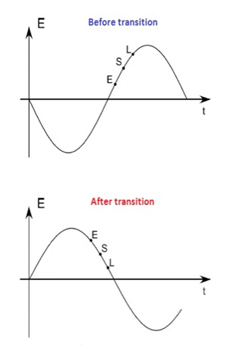Phase stability
 |
| These plots help us visualize electric field versus time in an RF cavity and show positions of early (E), on time (S) and late (L) particles in a beam bunch before and after transition. |
We skipped ahead in my last column to discuss accelerator tunes without finishing the subject of acceleration. In an earlier column I attempted to make a convincing argument that the best way to accelerate particles to high energies is to bend them in a circle and pass them through an electric field many times. A practical field for this purpose is one that oscillates sinusoidally at radio frequencies (RF) in a resonant cavity (see above figure). (Multiple cavities are strung together, forming the particle beam's accelerating path.) Today I will discuss beam stability during acceleration in such a field while introducing the problem of transition.
In order for charged particles to be accelerated in an oscillating field, they must be present in the RF cavity during the part of the cycle when the field is oriented to provide an acceleration. Typically bunches are formed in the beam by either knocking out particles that are out of time with upstream devices or letting nature take its course to lose them. This leaves only particles that are in time with the accelerating field. Even so, the nature of the sine wave is such that particles arriving at slightly different times receive slightly different accelerations due to the varying voltage. We can be clever by phasing the RF field so that the faster particles receive a smaller acceleration and the slower particles come later when the field is nearer the peak value (see figure). This results in stable oscillations of the individual particles from the slow part of the bunch to the fast part and back again many times during acceleration. An ideal particle right in the center of the bunch does not oscillate at all. The rest of the particles in the bunch oscillate around the ideal particle. Such oscillations are called synchrotron oscillations.
As usual the real picture is more complicated, and much of the complication is due to Albert Einstein. The theory of special relativity imposes a speed limit c, the speed of light, on the accelerating particles. (Accelerator scientists were not given a vote on this.) As the beam particles approach c during acceleration, the increase in velocity slows, even though the energy continues to rise, due to increasing mass and momentum. Further increases in energy do not change the velocity of the particles. However, the higher-energy particles bend less
in the accelerator magnets, causing them to follow a slightly longer path around the accelerator than the lower-energy particles. The result is that the particles with higher energy arrive in the RF cavities late instead of early. The point where orbit times become longer for the higher-energy particles is called transition. To maintain stable beam beyond transition, we must shift the phase of the RF curve so that the beam bunches fall on the right of the RF peak (see figure). This way, the higher-energy particles arrive late to get a smaller acceleration and vice versa with the low-energy particles.
One might ask why the beam is not centered right at the top of the RF wave. This solution is always unstable for the beam, since both early and late particles get smaller accelerations, causing the beam to spread out and be lost. Furthermore, shifting the RF phase to move the beam from one side of the curve to the other at transition cannot be accomplished without incurring some beam loss. All sorts of pulsed magnets, baling wire and chewing gum solutions have been devised to facilitate moving the beam through transition. None of them work perfectly.
Nevertheless, accelerator scientists enjoy problems like this because it gives them an opportunity to be clever, and if they succeed in minimizing the losses, they can pretend they are beating Einstein at his own game. Einstein wouldn't care. He was more interested in trains, twins, clocks and measuring rods.
—Roger Dixon
Want a phrase defined? Have a question? Email today@fnal.gov
|